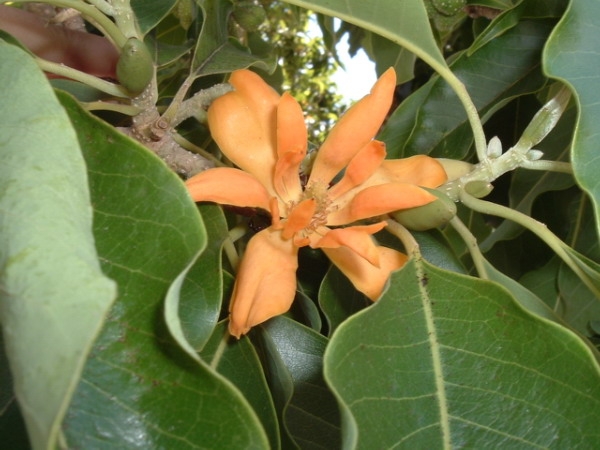Champak
(Magnolia champaca)
Champak (Magnolia champaca)
/
/

Denis Conrado
CC BY-SA 3.0
Image By:
Denis Conrado
Recorded By:
Copyright:
CC BY-SA 3.0
Copyright Notice:
Photo by: Denis Conrado | License Type: CC BY-SA 3.0 | License URL: http://creativecommons.org/licenses/by-sa/3.0/ | Uploader: Conrado | Publisher: Wikimedia Commons | Title: Magnolia1.jpg |



























Estimated Native Range
Summary
Magnolia champaca, commonly known as Champak, is an evergreen tree native to the tropical and subtropical forests of South and Southeast Asia. It is a large tree that can grow up to 50 meters (160 ft) tall with a trunk diameter of up to 1.9 meters (6.2 ft). The tree features a narrow umbelliform crown and is renowned for its strongly fragrant flowers, which come in shades of cream to yellow-orange and bloom from June to September. The flowers are particularly showy and attract butterflies and hummingbirds, while its aril-covered seeds are highly attractive to birds.
Champak is valued for its ornamental qualities, including its elegant form and the intense fragrance of its flowers. It is used as an ornamental tree, for dense screening hedges, and in tropical to subtropical gardens, such as those in coastal Southern and Central California. In cooler temperate climates, it is often planted in containers. The tree thrives in full sun and requires regular watering. It prefers soils with medium drainage and can adapt to a range of soil types, provided they are well-drained. While it is generally easy to maintain, it can be susceptible to scale insects and mealybugs. Gardeners should also be aware that the tree’s large size at maturity may not be suitable for small gardens.CC BY-SA 4.0
Champak is valued for its ornamental qualities, including its elegant form and the intense fragrance of its flowers. It is used as an ornamental tree, for dense screening hedges, and in tropical to subtropical gardens, such as those in coastal Southern and Central California. In cooler temperate climates, it is often planted in containers. The tree thrives in full sun and requires regular watering. It prefers soils with medium drainage and can adapt to a range of soil types, provided they are well-drained. While it is generally easy to maintain, it can be susceptible to scale insects and mealybugs. Gardeners should also be aware that the tree’s large size at maturity may not be suitable for small gardens.CC BY-SA 4.0
Plant Description
- Plant Type: Tree
- Height: 20-30 feet
- Width: 16-24 feet
- Growth Rate: Slow
- Flower Color: Yellow
- Flowering Season: Spring, Summer
- Leaf Retention: Evergreen
Growth Requirements
- Sun: Full Sun
- Water: Medium
- Drainage: Medium
Common Uses
Bee Garden, Bird Garden, Border Plant, Butterfly Garden, Deer Resistant, Fragrant, Low Maintenance, Showy Flowers, Street Planting
Natural Habitat
Tropical and subtropical forests
Other Names
Common Names: Michelia , Champac , Champaca , Parfymmichelia , Champakam
Scientific Names: Michelia champaca , Magnolia champaca , Michelia champaea , Michelia rufinervis , Michelia tsiampacca var. blumei , Michelia tsiampacca var. champaca
GBIF Accepted Name: Magnolia champaca (L.) Baill. ex Pierre